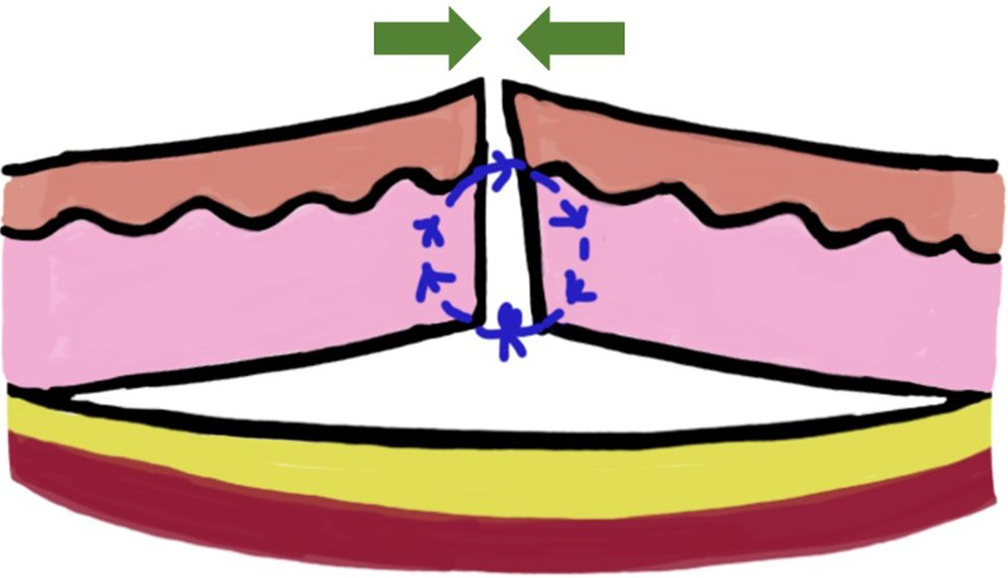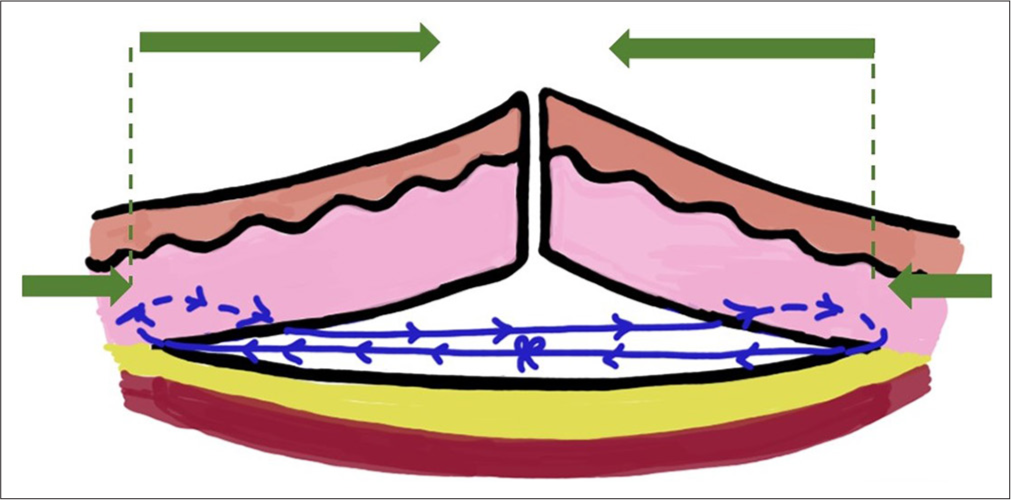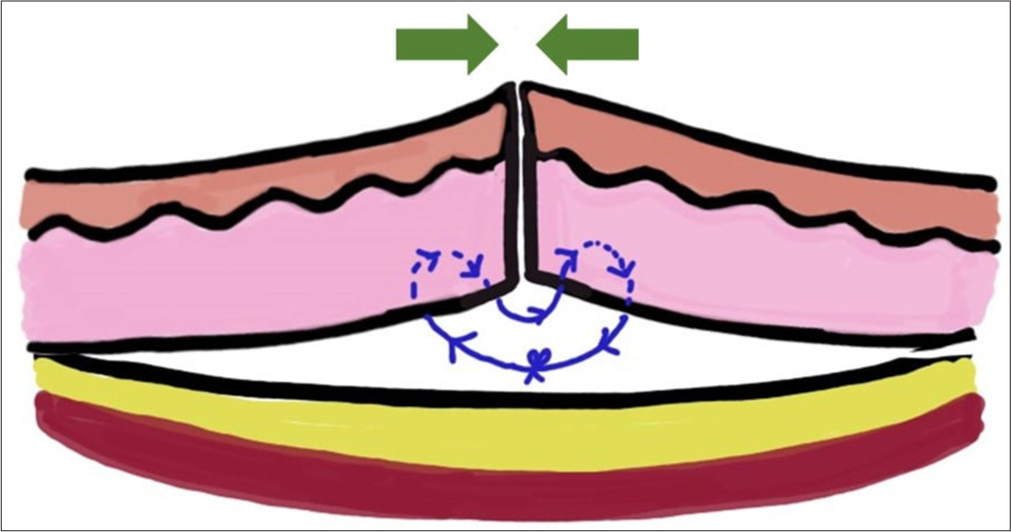Translate this page into:
Push-pull suture
*Corresponding author: Somesh Gupta, Professor, Department of Dermatology and Venereology, All India Institute of Medical Sciences, New Delhi, India. someshgupta@hotmail.com
-
Received: ,
Accepted: ,
How to cite this article: Sharma A, Choudhary R, Parvathy S, Gupta S. Push-pull suture. J Cutan Aesthet Surg. doi: 10.25259/JCAS_53_2025
Abstract
The enemy of an aesthetic wound closure is tension, and many buried suture techniques have evolved to take the tension away from epidermal sutures. However, all buried sutures continue to exert a pull on tissue of both sides towards the wound line, thus retaining tension at the wound line itself. We propose the push-pull suture, that modifies the wound tension vectors by pulling inwards at skin only beyond the v-junction where the superficial and deep parts of the undermined flaps meet, while the skin between the suture bite and the wound edge is gently pushed toward the wound line.This imparts wound edge eversion, obliteration of dead space, and elimination of tension across the wound line,aiding in tension-free closures of even large incisions against relaxed skin tension lines, and sometimes obviating the need for staged procedures.
Keywords
Buried suture
Dermatosurgery
Modified suture
Suturing techniques
Wound tension
PROBLEM STATEMENT
The ideal goal of any surgical intervention for a cosmetic indication is an esthetic outcome, which depends significantly on tension-free skin suturing. All skin wounds should thus ideally be closed in two layers, with the dermal-subcutaneous buried suture taking up the brunt of the tension to pull together the tissue at the wound edge, thus removing tension from the epidermal skin sutures. However, even with a two-layered closure, the point of tension remains at the wound line itself [Figure 1].1 Moreover, these buried sutures alone may not be able to oppose edges easily in larger wounds, especially when the closure is oriented against the skin tension lines, or in areas with limited extensibility of skin, such as the back and limbs. In such cases, lesions or scars often have to be excised “serially,” leading to multiple staged procedures, increased cost, inconvenience, and prolonged time to the eventual goal. We propose a push-pull suture to modify the opposing vectors causing tension at the wound line such that the actual wound margins are “pushed” together by the action of a deeper suture that “pulls” together the skin just beyond the undermined tissue.

- Standard dermal-subcutaneous buried suture creating pull vector at the wound edge. Green arrow: Pull vectors, Blue circle: Suture material.
RECOMMENDED SOLUTION
The push-pull suture is applied similarly to a conventional buried suture, but the suture bites are taken at the lateralmost point of the ventral aspect of an undermined flap of tissue on both sides rather than at the wound line [Figure 2]. The bite can be taken in a horizontal or vertical plane and often creates a temporary dimple on the overlying skin, which resolves spontaneously. We have found that taking a horizontal bite creates less of a dimple and holds the tissue better. Care should be taken that the suture does not pierce through the flap to the external surface. The suture is then tied in the midline, and the knot remains deep enough to not interfere with subsequent buried dermal and skin sutures. The pull vector of this suture is exerted at a point much more lateral to the wound edge specifically at the v-junction where the superficial and deep parts of the undermined flap meet. This results in a dual effect: The skin between the suture bite and the wound edge is gently pushed toward the wound, while the skin beyond the undermining limits is simultaneously pulled inward [Figure 2]. This imparts wound edge eversion, obliteration of dead space, and elimination of tension across the wound line. Unlike conventional subcutaneous sutures, which only pull the edges together, the Push-Pull technique also redistributes tension by incorporating a pushing force, leading to a more stable and less tension-prone closure. Subsequently, buried dermal and skin sutures can be placed at the wound line easily for finessing the precise approximation of wound edges for best esthetic outcome. The technique is demonstrated in Video 1 and is especially useful for primary closure in large wounds. We have attempted this technique in multiple patients, both on facial and non-facial skin, with good cosmetic outcomes. Another reported modification of conventional buried suture is the setback suture, where bites are taken from the undersurface of flap adjacent to incision line [Figure 3].2 Although this modification also helps in pushing margins together and eversion of wound margins, tension remains on the tissue near the incision line. In addition, dermal sutures are difficult to be applied along with this suture.

- Push-Pull suture moving the pull vector laterally to cause pushing together of the wound margins. Short green arrow: Pull vectors, Long green arrows: Push vectors, Blue line: Suture material.

- Diagrammatic representation of set-back suture, causing eversion but retaining the pull vector at the wound line. Short green arrow: Pull vectors, Blueline: Suture material.
Video 1:
Video 1:Intra-operative video demonstration of technique of push-pull suture in a large scar on the back.We thus propose the push-pull modification with a plausible biomechanical rationale, which will help dermato-surgeons and plastic surgeons in tension-free closure of large incisions and reduce the need for staged procedures to achieve better cosmetic outcomes.
Authors contributions:
Somesh Gupta conceptualised the idea; Ananya Sharma, Rajat Choudhary, Sree Parvathy and Somesh Gupta carried out the method in multiple cases and observed outcomes, Ananya Sharma and Rajat Choudhary drafted and edited the manuscript, all authors were involved in revision of manuscript.
Ethical approval:
Institutional Review Board approval is not required.
Declaration of patient consent:
The authors certify that they have obtained all appropriate patient consent.
Conflicts of interest:
There are no conflicts of interest.
Use of artificial intelligence (AI)-assisted technology for manuscript preparation:
The authors confirm that there was no use of artificial intelligence (AI)-assisted technology for assisting in the writing or editing of the manuscript and no images were manipulated using AI.
Financial support and sponsorship: Nil.
References
- The origin and development of interrupted subcuticular suture: An important technique for achieving optimum wound closure. Dermatol Surg. 2022;48:619-24.
- [CrossRef] [PubMed] [Google Scholar]
- The set-back buried dermal suture: An alternative to the buried vertical mattress for layered wound closure. J Am Acad Dermatol. 2010;62:351-3.
- [CrossRef] [PubMed] [Google Scholar]







